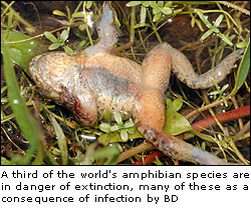Deadly frog disease is linked to climate change in Europe, say researchers

Climate change in Europe is worsening the impact of a deadly disease which is wiping out vast numbers of amphibians, according to new research.
The study, published today in the journal Proceedings of the Royal Society B, looks at changes in the populations of common midwife toads in a mountainous region of Spain over a period of 26 years.
The researchers, from Imperial College London and two Madrid institutions, found a correlation between significant warming of the local climate in Spain between 1976 and 2002 and the emergence of the fungal disease Batrachochytrium dendrobatidis (BD) in the area.
The fungus infects amphibians' skin and is believed to cause disease by interfering with the skin’s ability to absorb water. As a result of BD, the common midwife toad is now virtually extinct in the area of Spain studied by the researchers, the Penalara Natural Park, where it was once thriving.
The researchers suggest it is likely that increases in the number of BD-related mass mortalities are due to a combination of factors relating to climate change. As amphibians are cold-blooded, their body temperature is linked to the surrounding environment, meaning that changes in external temperature may affect their bodies' ability to respond to disease. The researchers also believe that BD may be better able to thrive in warmer conditions, with milder winters allowing it to survive and grow throughout the year.
The researchers now want to assess whether changing climatic patterns are likely to impact on the rates of BD in amphibian populations across the rest of Europe.
Dr Matthew Fisher , from the Department of Infectious Disease Epidemiology at Imperial College London, and one of the authors of the paper, said: "You can’t overstate how serious this pathogen is - it is the worst infectious disease ever recorded among vertebrates in terms of the number of species impacted, and its propensity to drive them to extinction. When you look at the reality of the disease it's the hardest hitter there is and the amphibian tree of life is being very severely pruned by it.
"This is a wake up call that we are losing biodiversity fast. Climate change appears to be changing patterns of disease and previously resistant species are becoming highly infected and even, in a number of cases, becoming extinct," he added.
The new study follows on from the Global Amphibian Assessment survey published in Science earlier this year, which revealed that a third of the world's amphibian species are in danger of extinction, many of these as a consequence of infection by BD.
The research was carried out by scientists from Imperial College London, the National Natural Science Museum, Madrid and the Universidad Europea de Madrid. It was funded by the Natural Environment Research Council (NERC), UK and BBVA Group, Spain.
Source: Imperial College London


















